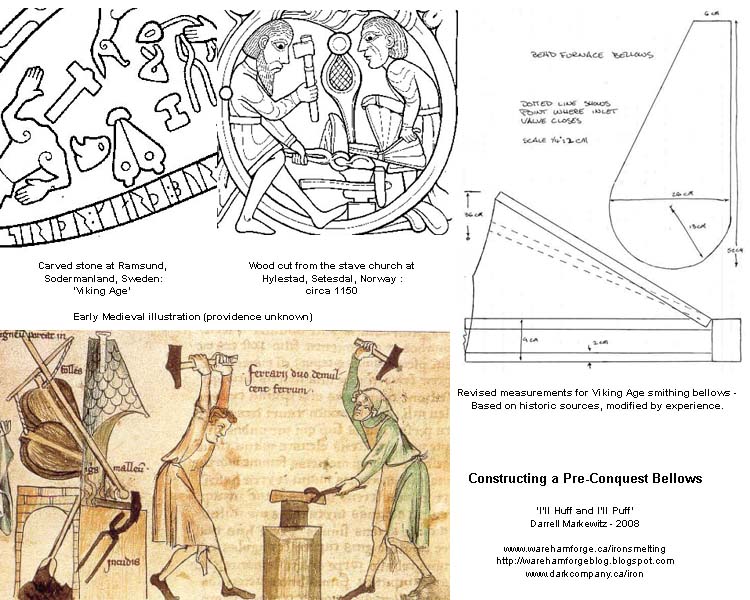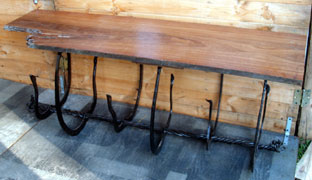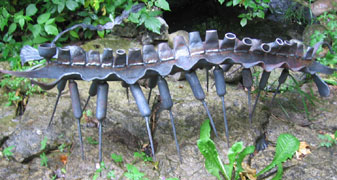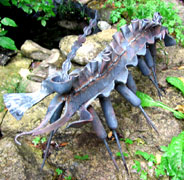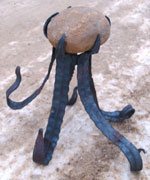With travelling and working with others, plus managing a large number of smelts here in Wareham, I have had occasion to use a number of different charcoal types for iron smelting.
The size furnaces being used at Wareham typically run between 40 - 80 kg charcoal per smelt. This is usually purchased as 8 kg (20 lb) bags, usually 10 - 15 bags at one time. (A standard skid of that size runs about 16 bags.)
I have ranked the commercially available charcoals I have worked with in the past - from 'best to worst':
Black Diamond - Oak & Hickory
This material was prepared by a small scale private operation. The fellow had been experimenting with small charcoal retorts - on much the same level as our iron smelting. The source was deadfall off his own property. This lead to a mix of wood types, but a uniformity of starting material that yielded an extremely consistent charcoal. Bruce Cowan was also offering me an excellent price on bulk amounts.
This material was made to order, so extremely dry and effective in the furnace. He also was pre-sizing and pre screening the material, the fines packed separately. Certainly by far the best material in my experience.
Made outside Niagara Falls, I did have to pick it up at source. Unfortunately, the operation (even at such a small scale) was forced to close due to complaints from neighbours.
ROYAL OAK - Oak
This was the original standard here in Wareham. Our first retail purchases were made of this brand, based mainly on what was locally available. Later I would contact Royal Oak directly, on the hopes of getting wholesale pricing. It turned out my desired quantities were too small. In the end Royal Oak generously donated charcoal to DARC. (Thank you Royal Oak!) This would total three skid loads, which supported our experiments here for several years.
I have found Royal Oak the best commercially available charcoal. It is extremely consistent on dryness, piece size and completeness of charring. The material breaks well with an average amount of fines produced.
The head office is in Georgia, the material is from that area of the United States.
MAPLE LEAF - Maple
This is our current standard at Wareham. My local supplier is McDonald's Home Hardware in Dundalk, who provide me bulk amounts at their own wholesale cost (a donation of roughly $4 per bag).
I have found the Maple Leaf to also be extremely consistent in quality. This material does tend to shatter more than the oak, resulting in a slightly higher amount as fines.
The head office in in Quebec, and the material is from that province (Trois Rivieres ?).
BASQUES CHARCOAL - Maple
In an attempt to find a wholesale source for charcoal, I had contacted a supplier outside Barrie who handles this brand. Although the price per bag is reduced on large purchases, the cost of the hauling from the yard raises the cost to equivalent to what I get for the discounted Maple Leaf. The material is produced primarily for restaurants which grill on charcoal.
As another maple charcoal, the characteristics are similar to Maple Leaf, as is the quality of the processing.
The head office in in Quebec, and the material is from that province (Riviere du Loop).
DanCook - Beach (?)
This was the material supplied for the 2008 Heltborg symposium. My experience certainly only rests on two full smelts, although it was used in a number of other furnaces effectively over the event.
Generally I would put the quality and handling characteristics here about on level with the Maple charcoals.
Only available in Denmark (?)
Cowboy - Mixed, primarily Oak
This brand was purchased in bulk for Early Iron 1 and 2.
The overall quality of this charcoal varies considerably from bag to bag. The material I have seen is primarily made from old oak rail road ties. Bags have been found to contain fist sized rocks, rail spikes, even whole track plates. Often the material is not completely charred. 'Inconsistent' would be the best description. Generally the unevenness of the charring means more work during braking.
The material is not available in Canada. Descriptions from other experimenters suggests the actual source wood does vary, depending on what part of the USA you are purchasing (suggesting multiple processing locations).
'Unknown' - Tropical Hardwood
This brand was purchased in bulk for Early Iron 3. (I checked my records, and could not find the supplier - or a single image of a bag.) The material was created from clear cutting in the Amazon. The method was simple pile burning. In this the wood types were randomly mixed, and unknown. An attempt was made on the bags to justify this combination of methods 'it was going to be wasted otherwise'.
The material was very inconsistent in piece size, density and degree of charring. Generally it was fine to break, but the effects varied piece by piece. In use the charcoal seemed to generate more 'ugly slag' than typical from North American hardwoods.
This material not available in Canada. The price was reduced, despite shipping, because of the source materials.
 |
| Neil Peterson breaking Royal Oak, June 2003 |
A pound is a pound is a pound.
Any given wood, if fully converted to charcoal, should produce the same energy on burning. The theory here is that a pound of carbon creates the same BTU - regardless of the source.
Where the theory falls apart is on relative density. A pound of oak charcoal occupies less physical *volume* than a pound of pine charcoal. This will impact on the best possible design for a furnace, effected by the fuel type available.
First thing will be considering the stack height (distance from tuyere tip to top of furnace). Lee Sauder often (properly) corrects me when I dwell on 'stack height', because the real consideration is *hang time*. As with any chemical reaction, there is a variable of time of reaction in the reduction of iron inside the furnace. As a general consideration, a lighter, less dense charcoal will be consumed faster, a greater volume being required to produced the required energy. Because the fuel column is collapsing faster, there needs to be some increase in that stack height to ensure the individual particles of ore have enough time at temperature for the chemistry.
There is possibly a factor of 'fit and lift'. Charcoal burns off its surface, so it may be that with lower density types, the particle size should really be increased, both at the lower and upper size range. At a given air delivery pressure, certainly a lower density charcoal, of the same size particle, is more likely to experience more 'lift' force. This is unlikely to result in fuel being blown out of the tall stack, but might result in a void at the position in the bottom of the furnace of highest temperature. Is this just a theoretical, or actual physical consideration?
A third variable will be the content of other elements beside carbon between various wood types. Pine for example, is said to be very ash free. The tropical hardwood listed above certainly seemed to be contributing more silica to the furnace environment.
In all three factors, there is still much room for measured experimentation and research before the variables are completely understood.
Historically, there is every evidence that there was no attempt to select for specific wood species at smelting sites. The variation in species seen in the charcoal remains does appear to reflect the same balance as what ever types were growing nearby and available. Later records to often comment on the desirability of certain hardwoods - specifically oak, with European ash or North American hickory also mentioned.
It is clear however, that the exact design of an iron smelting furnace was always modified from an idealized system to reflect the best results for a local ore. This may also extend to modifications to deal with variations caused by differing available wood types.
This is something that as modern producers, experimenters and researchers, we should always keep in mind. There is absolutely *no* 'one size fits all' small scale bloomery design. It is more the case that our small furnaces suffer the *most* from variations of ore type most certainly, and perhaps charcoal type as well. The current descriptions available from early experimenters such as Sauder & Williams, McCarthy and myself (to mention the North American pioneers) certainly are a reflection of many trials and much error.





